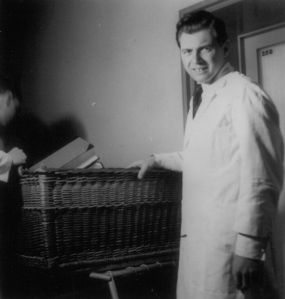If you look up underachiever in the dictionary you won’t find Lee Goldberg. One of the most prolific writers I’ve ever known, Lee has published more than two dozen books and has written and produced for TV such varied shows as Spenser: For Hire, Nero Wolf, Martial Law, Diagnosis Murder, Monk, SeaQuest, and even Baywatch.
It is my pleasure to welcome my good friend to The Writer’s Forensics Blog.
DPL: You wrote the tie in novels for Diagnosis Murder and now for Monk. Many people aren’t exactly sure what a tie in novel is. How do they differ from other novels?
LG: A tie-in novel is an original book based on a pre-existing media property, like a TV series, movie or game. The books are written with the approval and authorization of the creator, studio, producer…basically, whoever actually owns the underlying characters and concept. I wrote eight original DIAGNOSIS MURDER novels and am now working on my 12th original MONK book. There are about 40 original MURDER SHE WROTE novels and there must be a couple hundred STAR TREK books out there.
DPL: How did you get started in this arena?
LG: I was an executive producer and principle writer of DIAGNOSIS MURDER. A year or two after the show was cancelled, Penguin/Putnam (the publisher) and Paramount Studios (the copyright holder) contacted me with a three-book deal to write books based on the series. It was too good of a deal to pass up. And since I was the executive producer of the show, I only had to answer to myself as far as approvals go (on most tie-ins, you need to get approval on the story, the manuscript, etc. from the rights holder). Paramount certainly wasn’t going to second-guess me on what made a good DM story…and never tried.
When Andy Breckman, the creator/showrunning of MONK, was approached about doing original novels based on his series, he immediately thought of me. That’s because he was already a fan of my DM novels and I’d written several episode of the MONK, so he knew he trusted me with the character and he knew I could write books.
DPL: What’s the hardest part of writing these types of novels?
LG: Capturing the feel of the show, and the voices of the characters, while also kicking things up a notch. You have to offer the reader something more than they are getting from simply watching the show (or the reruns). It’s also difficult, particularly with a long-running series, to come up with stuff that the writers haven’t already tackled.
DPL: You have a new Monk book coming out July 3rd. What can you tell us about it?
LG: The book is MR. MONK IS CLEANED OUT and it’s the last book set before the finale of the TV series. This one is set in the midst of the current national economic crisis. The SFPD has to make draconian cutbacks to save money… so they fire Monk as a consultant. Monk figures he can live off his savings for a while. Then Natalie learns that Monk invested his money some time ago with Bob Sebes, the charismatic leader of Reinier Investments, who’s just been arrested on charges of orchestrating a massive $100 million fraud. All of Sebes’ clients, including Monk-are completely wiped out. Monk is broke…he can’t even afford to pay Natalie. So they end up taking all kinds of odd jobs. Meanwhile, when the key witness in the government’s case against Sebes is killed, Monk becomes convinced that Sebes did it, even though the man has been under house arrest with a horde of paparazzi in front of his building 24/7. I hope people have as much fun reading it as I had writing it!
DPL: You also wrote an episode for the new A&E series The Glades, a series I’m looking forward to. What’s the premise of the series? Can you give us any hints about the episode you wrote?
LG: The show is about a Chicago cop who gets fired and gets a job as a detective in a fictional town in Florida. The character has a certain Jim Rockford kind of charm and a Sherlockian gift for solving murders. It’s a light-hearted, blue-skies kind of show, very much like the sorts of stuff the USA Network has been doing so well. My episode is about women involved in “the girlfriend experience,” a new class of escort/call girl who offer more than just sex for money…they also wash your car. Okay, I made up the bit about washing cars. You’ll just have to watch the episode to learn more..
DPL: You’ve also ventured into e publishing some of your older books. How is that going?
LG: It’s going great! Almost all of my out-of-print books are now available on the Kindle and the iPad…and it’s astonishing to me how many copies I am selling. My book THE WALK has done far, far better on the Kindle than it ever did in hardcover. The Kindle is breathing new life… and generating new royalties… from stuff that I thought was dead.
DPL: What’s next for the always prolific Lee Goldberg?
LG: I am writing my 12th MONK novel, a western movie, and it looks like my feature adaptation of Victor Gischler’s GUN MONKEYS may soon be going into production with an Oscar-winning Star in the lead role. But I can’t say more about that just yet.
Lee, thanks for being with us.
Visit Lee’s Website at: http://www.leegoldberg.com
And his blog A Writer’s Life at: http://leegoldberg.typepad.com































